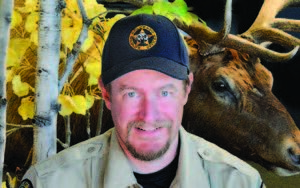Aaron Berscheid is a district wildlife officer for Colorado Parks and Wildlife. Aaron covers the ìwildî side of Northeast El Paso County, including Black Forest, Falcon, Peyton and Calhan. He also covers some of Elbert County, north of U.S. Highway 24 and south of State Highway 86, including the towns of Elbert, Kiowa, Ramah, Simla, Matheson and a small portion of the Limon area.
Editorís Note: This is a regular monthly column from Colorado Parks and Wildlife about wildlife issues in the Falcon area by a career wildlife officer.†As I was outside my truck last week checking hunters, I heard a familiar distant sound: a chorus of rattling trumpets.I scanned the sky; and, after squinting for a bit, finally located the originators of the call. Far above me, flying in a long ìVî formation, flew a flock of about 50 sandhill cranes.Their long wing beats and skinny legs trailing behind made them unmistakable, even at cruising altitude.Sandhill cranes are a migratory bird that, like many other birds, travel south for the winter. From the beginning of October through November, you can hear cranes as they make their way across the state. You may even be able to see them on the ground in shallow marshes, grain fields or even small ponds.They are worth making a little effort to see.They are a tall bird with a red crest on their forehead and slate gray to rusty red feathers. Their beaks are sharp and their legs are long. The birds that migrate through Colorado are the largest of the North American sandhill subspecies standing 4-feet tall, having a wingspan of up to 7 feet and weighing in at 11 pounds. Besides their imposing size, the birds issue a continuous, distinctive and haunting call.†In the spring, they make their way back north. Large flocks of birds pass through Colorado and many stop in the San Luis Valley to feed in the marshes.†The cranes start arriving in mid-February, flying from their winter nesting ground, primarily in New Mexico. The large wetland areas, wildlife refuges and grain fields in the San Luis Valley draw in upward of 25,000 birds. The cranes stop in the valley to rest up and re-fuel for their trip north to their summer nesting and breeding grounds in Idaho, Montana and Wyoming.Itís impressive to see them fill the air and hear their huge wings flap as the flocks take off and land in large groups. Consider that these magnificent birds are among the oldest living species on the planet: Fossil records for cranes date back nine million years. Remember that as you watch them doing their dances as they try to impress and court a mate.Sandhill cranes are closely related to the whooping crane. Whooping cranes are snow white in color, and there are far fewer numbers. There are so few whooping cranes that they are actually endangered. Fortunately, sandhill crane populations are robust and in large enough numbers that hunting is used as a conservation tool for these birds.†If you are a waterfowl hunter, you might like to bag a bird that has been called the ìRibeye of the Sky.î Just know that by the time the cranes reach Colorado, they are very weary and do not decoy easily, making opportunities for these birds few and far between.†So as youíre out and about the next couple of weeks, keep your ears to the sky. You will more than likely hear them before you see them. Enjoy them as they move through the thin autumn skies(Special thank you to Roger for the article suggestion!)In the coming months, Iíll share more of those stories as I write about wildlife issues in our community: Got a question, problem or column idea, please email me at aaron.berscheid@state.co.us or call me at 719-227-5231.†I might even answer your question in a future installment of ìWildlife Matters.î




